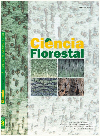
|
Ciência Florestal
Centro de Pesquisas Florestais - CEPEF, Departamento de Ciências Florestais - DCFL, Programa de Pós Graduação em Engenharia Florestal - PPGEF
ISSN: 0103-9954
EISSN: 0103-9954
Vol. 29, No. 1, 2019, pp. 270-280
|
 Bioline Code: cf19022
Bioline Code: cf19022
Full paper language: Portuguese
Document type: Research Article
Document available free of charge
|
|
|
Ciência Florestal, Vol. 29, No. 1, 2019, pp. 270-280
| pt |
Distribuição do diâmetro de copa e diâmetro quadrático de Araucaria angustifolia  e Pinus taeda e Pinus taeda 
Debastiani, Aline Bernarda; Martins, Luciellen Pereira; Santos, Kênia Samara Mourão; Corte, Ana Paula Dalla; Pellico Netto, Sylvio & Sanquetta, Carlos Roberto
Resumo
As funções de densidade de probabilidade têm várias aplicações florestais, entre as quais o tratamento
de dados biométricos e uso em modelagem. O objetivo deste estudo foi verificar qual função densidade
de probabilidade melhor se ajusta ao diâmetro de copa (dcopa) e ao diâmetro quadrático (dq), e também
analisar o efeito dessas variáveis na estrutura da floresta. O estudo foi realizado com uma base de dados
de Araucaria angustifolia provenientes de um fragmento florestal, e também com dados de Pinus taeda
de um plantio florestal, ambos oriundos do estado do Paraná. Para as respectivas áreas de estudo foram
delimitadas as copas das árvores com suporte de ortofotos digitais. As funções avaliadas foram: Normal,
Log-normal 2P, Beta, Gama, Weibull 3P e Weber. A função que melhor se ajustou à variável dq para ambas
as espécies foi a Normal. Já para a variável dcopa, a função de Weibull 3P foi a que apresentou melhor
aderência para o fragmento de araucária e a função de Weber para o plantio florestal de pinus
Palavras-chave
Ortofotos; Mensuração Florestal; Estrutura florestal
|
| |
| en |
Distribution of the cup diameter and the quadratic diameter of Araucaria angustifolia  and Pinus taeda and Pinus taeda 
Debastiani, Aline Bernarda; Martins, Luciellen Pereira; Santos, Kênia Samara Mourão; Corte, Ana Paula Dalla; Pellico Netto, Sylvio & Sanquetta, Carlos Roberto
Abstract
The probability density functions have several forest applications, among which biometric data processing
and modeling use. The objective of this study was to verify which probability density function best fits
the cup diameter (dcopa) and the quadratic diameter (dq), and also to analyze the effect of these variables
on the forest structure. The study was carried out with a database of Araucaria angustifolia from a forest
fragment, and also with Pinus taeda data from a forest plantation, both from the state of Paraná. For
the respective study areas, the crowns of the trees with digital orthophoto support were delimited. The
evaluated functions were: Normal, Log-normal 2P, Beta, Gama, Weibull 3P and Weber. The function that
best fit the variable dq for both species was Normal. For the variable dcopa, the function of Weibull 3P was
the one that presented better adhesion to the Araucaria fragment and the Weber function for the Pinus
forest plantation.
Keywords
Orthophotos; Forest measurement; Pinus; Forest structure
|
| |
© Copyright 2019 - Ciência Florestal
Alternative site location: http://cascavel.ufsm.br/revistas/ojs-2.2.2/index.php/cienciaflorestal/index
|
|
